by Dinesh Chandren
Togoru is a village on the largest island of Fiji in the South Pacific. It is home to five generations of the Dunn family, since James Dunn came all the way from Ireland to build this village. His great-great grandson James, still lives there, in one of only three houses still existing in the village.
What has happened?
Togoru is being swallowed by the sea. In the last century or so, sea levels have risen 25 centimetres on average, submerging more and more of Togoru and other settlements on Fiji. The rise in sea levels is caused by the effects of anthropogenic, or human-caused, climate change.
The village’s graveyard, which houses the graves of members of the Dunn family, has been largely submerged by the sea. James and his family members could no longer visit the graves of their ancestors. Togoru has built five seawalls in the last 25 years to fight the effects of the encroaching sea, but to no avail, as the sea continues to submerge not only the land, but memories and their way of life.
Anne Dunn, James’ niece says, “Climate change to me means that we couldn’t bury my father and my uncle at our traditional burial grounds,” she says, full of emotion. “It affects our identity. We are islanders, our unique way of living is being threatened.”
The village of Tukaraki on Fiji had had to relocate three times due to various disasters, some of which had been exacerbated due to climate change. While the modern dwellings in the latest Tukaraki can withstand the forces of a Category 5 cyclone, it cannot replace the loss of a traditional way of living. Livai Kidiromo, a village elder, laments, “For Fijians, land is the most important thing. It binds us. When we lost our land, we felt vulnerable and helpless.” (1)
Until not too long ago, we in Malaysia have felt relatively safe, as far as natural disasters and extreme climate events are concerned. However, in recent years, this belief has been gradually eroded, and the tipping point that has created grave worry about our resilience to the effects of climate change would be the December 2021 floods.
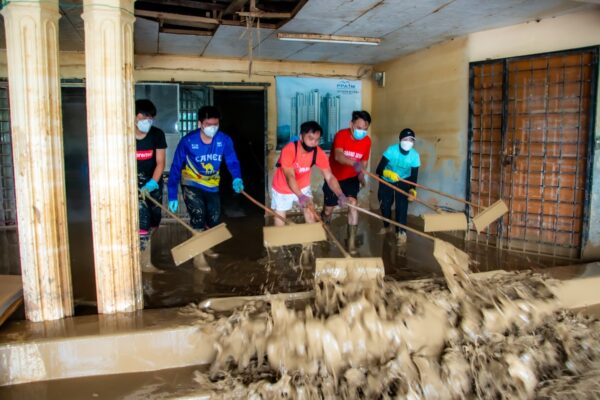 |
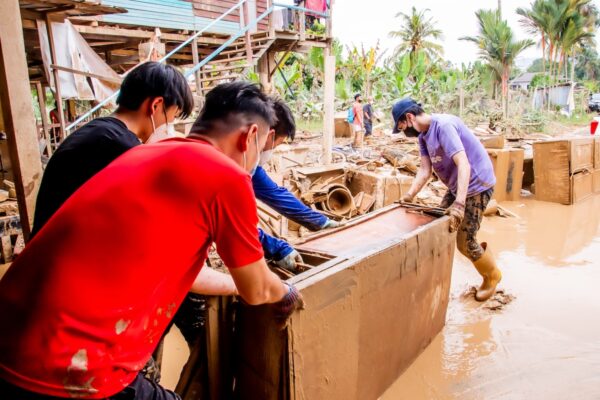 |
| SGM youths, working alongside others, have played a major part in leading SGM’s efforts in environmentalism and aiding those affected by the December 2021 floods. | |
More than 50 people died and tens of thousands were affected, with some losing all their possessions. It is believed that climate change has contributed to the unusually heavy rainfall that battered some areas for three days nonstop, causing record levels of rain and devastating floodwaters.
Days after the floods, many people were still trying to come to terms with their losses and cleaning up whatever they have left. Weeks later, heavy rain and predictions of thunderstorms would cause anxiety levels to increase, for fear that the floods would repeat themselves.
The COVID-19 pandemic had already taken a heavy toll on the mental health of Malaysians, and the floods further increased the burden. The Malaysian Mental Health Association said that they have been receiving more calls to their helpline after the floods. Dr Andrew Mohanraj, the association’s president and mental health expert said that continuous rains would cause fear and anxiety, adding that, “Traditionally, we often see ourselves as a safe country but the unexpected floods in certain areas have caused trauma to the people.”
Dr Mohanraj noted that the situation could exacerbate certain symptoms for those who already have mental health issues such as depression and anxiety. (2)
The above are just some examples of the various problems and challenges caused by climate change or what is increasingly being called the climate crisis.
In its report published in February, the Intergovernmental Panel for Climate Change (IPCC) has noted that since the Fifth IPCC Assessment Report published in 2014, a wider range of impacts can be attributed to climate change. It also notes that climate change impacts are expected to intensify with additional warming.
These impacts are also interacting with multiple other societal and environmental challenges. These include a growing world population, unsustainable consumption, a rapidly increasing number of people living in cities, significant inequality, continuing poverty, land degradation, biodiversity loss due to land use change, ocean pollution, overfishing and habitat destruction as well as a global pandemic. Intersecting trends can reinforce each other, intensifying risks and impacts, which affect the poor and most vulnerable people the hardest. (3)
Scientists have also discovered that adverse impacts due to climate change are happening faster than they had expected, and the window for us to take action in order to prevent irreversible changes from happening is closing very, very fast.
It can look like climate change, with its complexities and intricate relationships, can seem to be too much for ordinary people to handle. This can send us into a spiral of hopelessness and powerlessness.
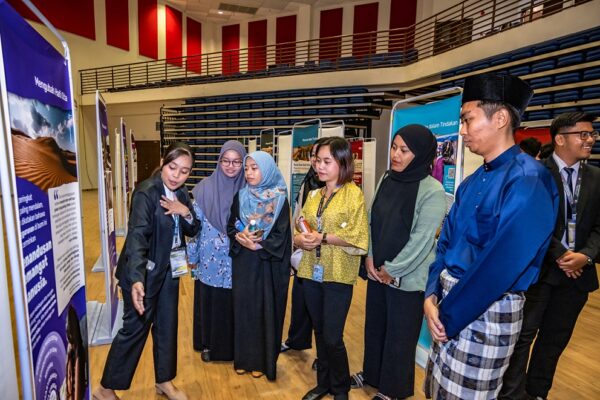 |
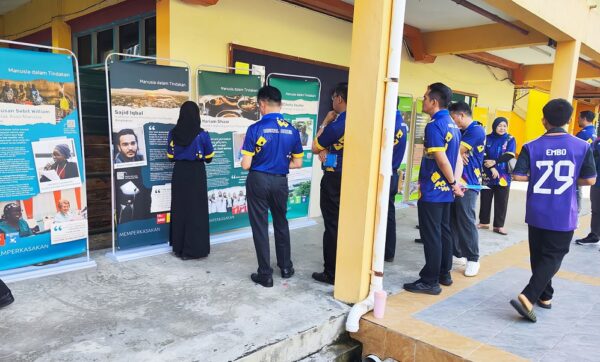 |
| “Seeds of Hope and Action” exhibition at UPSI in Tanjong Malim (left) and SMK Mukah in Sarawak (right). | |
However, SGI President Daisaku Ikeda has consistently stressed that the key to changing even the most complex and intricate of problems lies in individuals themselves undergoing a profound change within themselves.
Buddhism teaches that our lives and the environment that we life in are deeply interconnected. Human beings can only exist due to our relationship not just with other people but also in the environment that we live in, where we strive to live our daily lives.
If we only care about living a life that is unsustainable and harms the environment, we in the end we will find that the environment will become hostile and make our lives more difficult. In the end, all the environmental problems, including climate change, that we see stems from one source: the actions of us human beings.
But this also means the solutions for the climate crisis also lies with us – we need not look elsewhere. To paraphrase the preamble of the UNESCO constitution, “Since climate change begins in the minds of men, it is in the minds of men that the defences for climate change must be constructed.”
In President Ikeda’s 2002 proposal, Education for Sustainable Development, he advocated the Learn, Empower, Reflect formula to promote education for sustainable development:
To learn and deepen awareness of environmental issues and realities.
To reflect on our modes of living, renewing these towards sustainability.
To empower people to take concrete action to resolve the challenges we face
This formula has been applied and expanded upon in the “Seeds of Hope” exhibition and its successor, “Seeds of Hope and Action: Making the SDGS a Reality.”
The factors that have brought us to the current grave situation of climate crisis began undoubtedly with the activities of human beings. And since human beings caused climate change, then certainly we human beings too can be the solution to climate change.
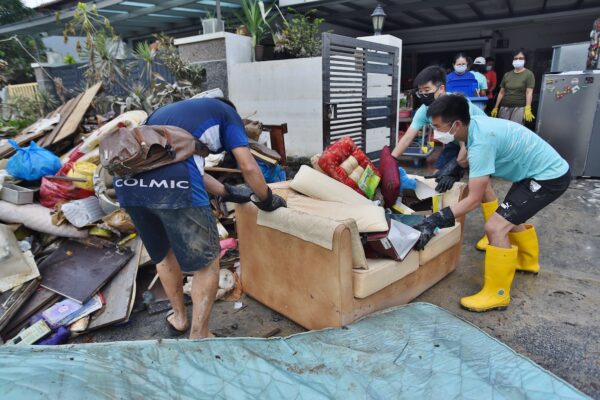 |
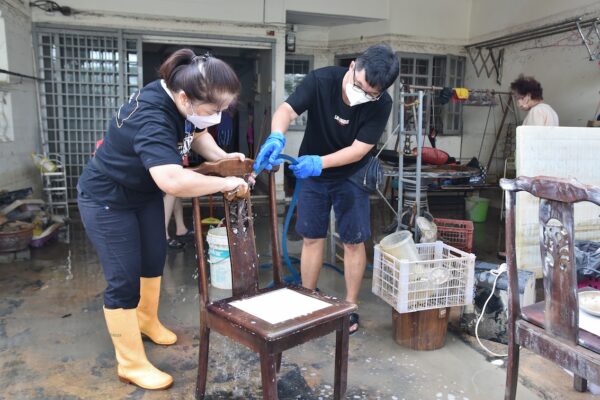 |
| SGM youths, working alongside others, have played a major part in leading SGM’s efforts in environmentalism and aiding those affected by the December 2021 floods. | |
President Ikeda writes succinctly:
The problems confronting human society cannot be solved solely by external changes, such as political and economic reforms or institutional and organisational innovation. Reform efforts that fail to take into account people’s wellbeing, or that lack respect for the dignity of life, will only create more problems and eventually run aground.
We must remember that the fundamental goal is people’s happiness.
Stay connected to the people! Awaken to the dignity and preciousness of life! Change must start with people themselves! Now is the time for humanity to return to these basic points.
Given all of this, what should be the central guiding principles of religion in the 21st century? I assert that they are humanism and human revolution. (4)
Our movement of humanism and human revolution is becoming more important than ever in confronting the gravest crisis confronting humanity.
Young people worldwide in particular have become the standard bearers in pioneering a change movement that seeks to move humanity away from the climate precipice. SGM youth too have played a major part in leading SGM’s efforts in environmentalism and aiding those affected by the December 2021 floods.
Let’s strive even harder, to make our world a better place, creating a hopeful, shining future based on the humanistic principles of Nichiren Buddhism!
Adapted from April 2022 Cosmic
Resources
IPCC Report: Climate Change 2022: Impacts, Adaptation and Vulnerability
Education for Sustainable Development Proposal (2002)
(1) https://reliefweb.int/report/fiji/nowhere-hide-climate-change
(2) https://str.sg/wgqM
(3) This refers to the Climate Change 2022: Impacts, Adaptation and Vulnerability report, authored by Working Group II, as its contribution to the IPCC Sixth Assessment Report. You may read the FAQs for this report at https://www.ipcc.ch/report/ar6/wg2/about/frequently-asked-questions/keyfaq1/ for an interpretation of the report’s concepts and findings for a broader audience.
(4) Daisaku Ikeda, A Religion of Human Revolution (Soka Gakkai Malaysia, 2021), pg 1-2.








